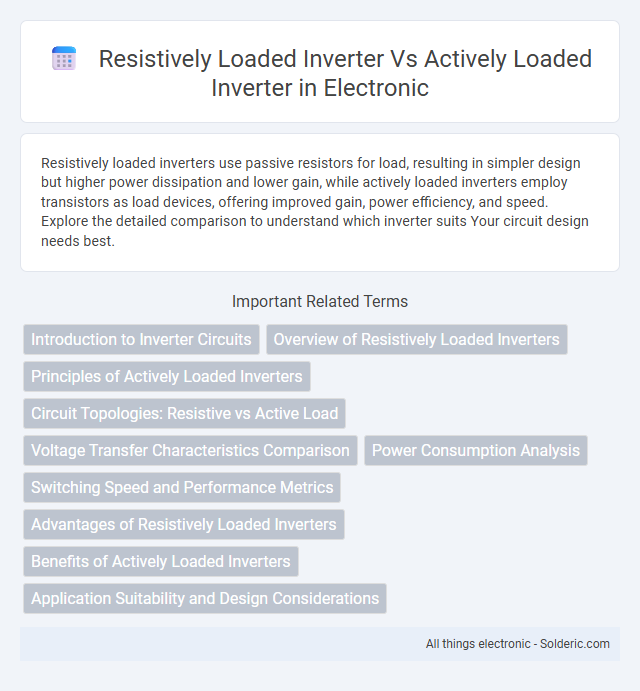Resistively loaded inverters use passive resistors for load, resulting in simpler design but higher power dissipation and lower gain, while actively loaded inverters employ transistors as load devices, offering improved gain, power efficiency, and speed. Explore the detailed comparison to understand which inverter suits Your circuit design needs best.
Comparison Table
| Feature | Resistively Loaded Inverter | Actively Loaded Inverter |
|---|---|---|
| Load Type | Resistor | Active transistor (usually MOSFET) |
| Power Consumption | High static power dissipation | Lower static power consumption |
| Voltage Swing | Reduced due to voltage drop across resistor | Higher, close to full supply voltage |
| Speed | Lower speed due to resistive load | Faster switching speeds |
| Area | Smaller circuit footprint (simple resistor) | Larger due to active transistor load |
| Design Complexity | Simple design | More complex design |
| Gain | Lower gain | Higher voltage gain |
| Common Applications | Basic digital logic, educational circuits | High-performance digital circuits |
Introduction to Inverter Circuits
Resistively loaded inverters utilize a passive resistor as the load element, leading to straightforward design but lower power efficiency and reduced voltage swing. Actively loaded inverters employ transistors as load devices, enabling improved performance through higher gain, better output voltage levels, and lower power consumption. These fundamental differences impact the overall speed, power dissipation, and integration capabilities in digital circuit design.
Overview of Resistively Loaded Inverters
Resistively loaded inverters use a passive resistor as the load element, offering simplicity and ease of design but suffering from significant power dissipation and limited voltage gain. The static power consumption remains high since current constantly flows through the resistor regardless of the output state, reducing overall energy efficiency. Resistively loaded inverters are commonly employed in basic digital circuits where simplicity is prioritized over performance metrics like speed or power efficiency.
Principles of Actively Loaded Inverters
Actively loaded inverters use transistors as load elements instead of resistors, enabling higher gain and better power efficiency compared to resistively loaded inverters. The active load operates in the saturation region, providing a constant current source that enhances voltage swing and speed. Your circuit benefits from improved performance due to reduced power dissipation and increased output impedance in actively loaded inverter designs.
Circuit Topologies: Resistive vs Active Load
Resistively loaded inverters use a simple resistor as the load element, offering straightforward circuit topology, but they suffer from higher static power consumption and limited voltage gain. Actively loaded inverters replace the resistor with a transistor, often a MOSFET, enabling significant improvements in voltage gain, reduced power dissipation, and better switching performance. Your choice between these topologies impacts overall circuit efficiency, speed, and integration complexity in digital and analog applications.
Voltage Transfer Characteristics Comparison
Resistively loaded inverters exhibit a gradual voltage transfer characteristic (VTC) with limited gain and reduced noise margins due to the linear resistor load, resulting in slower switching speeds and higher power dissipation. Actively loaded inverters utilize transistors as loads, producing a steeper VTC with higher gain and improved noise margins, which enhances switching performance and reduces power consumption. The sharper transition region in actively loaded inverters supports better signal integrity and faster operation in digital circuits compared to the resistively loaded counterparts.
Power Consumption Analysis
Resistively loaded inverters exhibit higher static power consumption due to continuous current flow through the load resistor, resulting in significant power dissipation even when the output is static. Actively loaded inverters use transistors instead of resistors, drastically reducing static power consumption by minimizing leakage currents and enabling dynamic operation. Your choice of inverter affects overall efficiency, with actively loaded designs offering superior power efficiency in low-power applications.
Switching Speed and Performance Metrics
Resistively loaded inverters typically exhibit slower switching speeds due to the constant current flow through the resistor, resulting in higher power dissipation and reduced performance efficiency. Actively loaded inverters leverage transistor-based loads, which enhance switching speed by minimizing voltage drops and enabling faster transition times, significantly improving gain and output swing metrics. Your circuit design benefits from actively loaded inverters when optimizing for high-speed operation and energy-efficient performance in digital applications.
Advantages of Resistively Loaded Inverters
Resistively loaded inverters offer simplicity in design and ease of implementation, making them ideal for low-frequency and low-power applications. Their linear load characteristics provide stable and predictable voltage transfer behavior, enhancing signal fidelity and reducing distortion. You benefit from lower manufacturing costs and straightforward biasing requirements compared to actively loaded inverters, which often require complex current sources.
Benefits of Actively Loaded Inverters
Actively loaded inverters offer improved voltage gain and faster switching speeds compared to resistively loaded inverters, enhancing overall circuit performance. Their ability to provide better power efficiency reduces static power dissipation, which is critical in low-power applications. You benefit from higher signal amplification and enhanced noise margins, making actively loaded inverters ideal for high-speed and low-power digital circuits.
Application Suitability and Design Considerations
Resistively loaded inverters are well-suited for simple, low-frequency analog applications where design simplicity and ease of implementation are priorities, though they suffer from higher power dissipation and slower switching speeds. Actively loaded inverters, employing transistors as load elements, offer improved voltage gain, faster switching performance, and better power efficiency, making them ideal for high-speed digital circuits and integrated circuit design. Your choice between these inverters depends on specific application requirements such as speed, power efficiency, and integration complexity.
Resistively loaded inverter vs Actively loaded inverter Infographic

 solderic.com
solderic.com